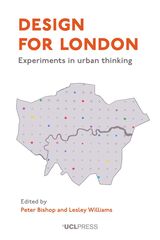3 books about Bishop, Peter

Bridge
Peter Bishop
Reaktion Books, 2008
Whether a humble string of planks swaying across a trickling stream or the soaring towers of the Golden Gate Bridge, bridges are one of man’s great engineering feats. Now in Bridge, Peter Bishop provides a comprehensive historical account of their role in the advancement of human culture.
From ancient Roman arches to the rail bridge of Lhasa to the suspension bridge over Niagara Falls, Bishop traverses the full span of the globe to examine numerous incarnations and their diverse architectural styles. The book tackles a wide range of issues, including the design and construction of “mega-spans” such as Hong Kong’s Tsing Ma Bridge; the integral role of bridges in railroad networks; and the social dynamics of class and mobility that surround urban bridges in cities such as New York. Drawing upon sources in art, politics, science, philosophy, and the media, Bishop argues that the cultural meaning of bridges today revolves around the idea of expanding geographical claims, rather than connecting to others, and he explores the implications of that idea for the future. A fascinating and richly illustrated study, Bridge will engage enthusiasts of planning, architecture, and design alike.
[more]

Design for London
Experiments in Urban Thinking
Edited by Peter Bishop and Lesley Williams
University College London, 2020
Design for London is the product of a unique experiment in urban planning, design and strategic thinking. Set up in 2006 by then-Mayor Ken Livingstone and his Architectural Advisor Richard Rogers, the brief for the team was “to think about London, what made London unique and how it could be made better.” At the time, large-scale state investment was often not an option, and political consensus was fragmented. In addition, cities, by their nature, are fashioned through complex negotiation and deal making that involves many different stakeholders with different agendas. All of these factors complicated the assignment—and made the resulting projects and ideas more interesting. This book aims to provide an engaging account of the strategic approaches and work of Design for London. It outlines how key projects such as the London Olympics, public space programmes, high street regeneration and greening programs were managed.
[more]

Repurposing the Green Belt in the 21st Century
Peter Bishop, Alona Martinez, Rob Roggema, and Lesley Williams
University College London, 2020
The green belt has been one of the UK’s most consistent and successful planning policies. It has limited urban sprawl and preserved the countryside around cities—but what is its role in an era of unprecedented urban growth and potentially catastrophic climate change? Repurposing the Green Belt in the 21st Century examines the history of the green belt in the UK and how it has influenced planning regimes in other countries. Despite the undoubted achievements of the green belt, the authors argue, it is time to review it as an instrument of urban planning and landscape design, now that the problem of the ecological impact of cities and the mitigation measures of major climate changes are at the top of the urban agenda across the world.
Through an examination of practice in the UK, the Netherlands, Spain, and Germany, Repurposing the Green Belt in the 21st Century proposes a framework for a reconsideration of the critical relationship between the city and its hinterlands. It will be useful for undergraduate and postgraduate students of planning, landscape architecture, urban design, architecture, and land economics, as well as practitioners in design, planning, and real estate.
Through an examination of practice in the UK, the Netherlands, Spain, and Germany, Repurposing the Green Belt in the 21st Century proposes a framework for a reconsideration of the critical relationship between the city and its hinterlands. It will be useful for undergraduate and postgraduate students of planning, landscape architecture, urban design, architecture, and land economics, as well as practitioners in design, planning, and real estate.
[more]
READERS
Browse our collection.
PUBLISHERS
See BiblioVault's publisher services.
STUDENT SERVICES
Files for college accessibility offices.
UChicago Accessibility Resources
home | accessibility | search | about | contact us
BiblioVault ® 2001 - 2024
The University of Chicago Press









